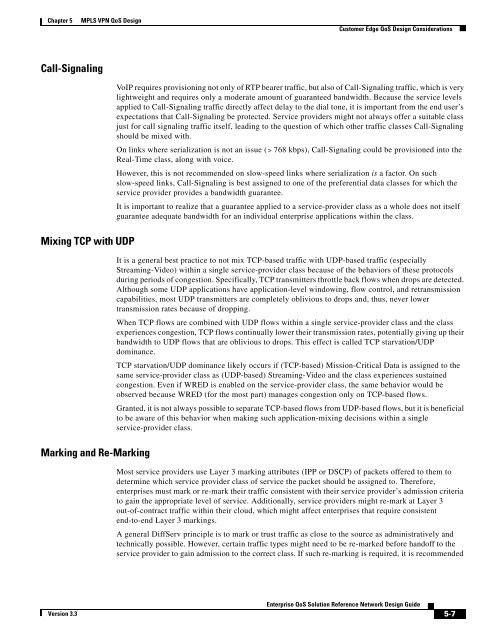Enterprise QoS Solution Reference Network Design Guide
Enterprise QoS Solution Reference Network Design Guide
Enterprise QoS Solution Reference Network Design Guide
You also want an ePaper? Increase the reach of your titles
YUMPU automatically turns print PDFs into web optimized ePapers that Google loves.
Chapter 5 MPLS VPN <strong>QoS</strong> <strong>Design</strong><br />
Call-Signaling<br />
Mixing TCP with UDP<br />
Marking and Re-Marking<br />
Version 3.3<br />
Customer Edge <strong>QoS</strong> <strong>Design</strong> Considerations<br />
VoIP requires provisioning not only of RTP bearer traffic, but also of Call-Signaling traffic, which is very<br />
lightweight and requires only a moderate amount of guaranteed bandwidth. Because the service levels<br />
applied to Call-Signaling traffic directly affect delay to the dial tone, it is important from the end user’s<br />
expectations that Call-Signaling be protected. Service providers might not always offer a suitable class<br />
just for call signaling traffic itself, leading to the question of which other traffic classes Call-Signaling<br />
should be mixed with.<br />
On links where serialization is not an issue (> 768 kbps), Call-Signaling could be provisioned into the<br />
Real-Time class, along with voice.<br />
However, this is not recommended on slow-speed links where serialization is a factor. On such<br />
slow-speed links, Call-Signaling is best assigned to one of the preferential data classes for which the<br />
service provider provides a bandwidth guarantee.<br />
It is important to realize that a guarantee applied to a service-provider class as a whole does not itself<br />
guarantee adequate bandwidth for an individual enterprise applications within the class.<br />
It is a general best practice to not mix TCP-based traffic with UDP-based traffic (especially<br />
Streaming-Video) within a single service-provider class because of the behaviors of these protocols<br />
during periods of congestion. Specifically, TCP transmitters throttle back flows when drops are detected.<br />
Although some UDP applications have application-level windowing, flow control, and retransmission<br />
capabilities, most UDP transmitters are completely oblivious to drops and, thus, never lower<br />
transmission rates because of dropping.<br />
When TCP flows are combined with UDP flows within a single service-provider class and the class<br />
experiences congestion, TCP flows continually lower their transmission rates, potentially giving up their<br />
bandwidth to UDP flows that are oblivious to drops. This effect is called TCP starvation/UDP<br />
dominance.<br />
TCP starvation/UDP dominance likely occurs if (TCP-based) Mission-Critical Data is assigned to the<br />
same service-provider class as (UDP-based) Streaming-Video and the class experiences sustained<br />
congestion. Even if WRED is enabled on the service-provider class, the same behavior would be<br />
observed because WRED (for the most part) manages congestion only on TCP-based flows.<br />
Granted, it is not always possible to separate TCP-based flows from UDP-based flows, but it is beneficial<br />
to be aware of this behavior when making such application-mixing decisions within a single<br />
service-provider class.<br />
Most service providers use Layer 3 marking attributes (IPP or DSCP) of packets offered to them to<br />
determine which service provider class of service the packet should be assigned to. Therefore,<br />
enterprises must mark or re-mark their traffic consistent with their service provider’s admission criteria<br />
to gain the appropriate level of service. Additionally, service providers might re-mark at Layer 3<br />
out-of-contract traffic within their cloud, which might affect enterprises that require consistent<br />
end-to-end Layer 3 markings.<br />
A general DiffServ principle is to mark or trust traffic as close to the source as administratively and<br />
technically possible. However, certain traffic types might need to be re-marked before handoff to the<br />
service provider to gain admission to the correct class. If such re-marking is required, it is recommended<br />
<strong>Enterprise</strong> <strong>QoS</strong> <strong>Solution</strong> <strong>Reference</strong> <strong>Network</strong> <strong>Design</strong> <strong>Guide</strong><br />
5-7
















